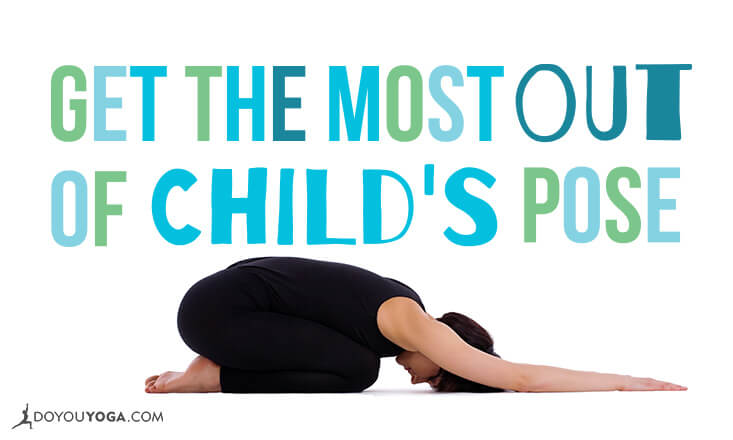Most yoga teachers will tell you to ‘come down to Child’s pose’ if you feel tired, overwhelmed, or in need of a rest during class. But Child’s pose doesn’t have to be a snooze.
Yes — Child’s pose or Balasana is very good for relaxing, especially if you drop to the floor for a rest to break up a set of strong balancing postures or in between sequences in a Warrior flow.
It can be a great transitional posture, releasing the lower back after deep back bending and providing a re-set for the nervous system between long-held yin postures.
And while Child’s pose may be child’s play, the seemingly simple nature of the asana may mask its many benefits and the ability to use the posture for more than a flop and drop.
Breath Awareness
There are few other postures that offer an opportunity for breath awareness like Child’s pose.
When we lie in Child’s pose, the abdomen is constricted against the thighs, which constrains our full-frontal chest breathing (the normal way we breathe). So the belly can only expand so far with the inhale breath, and if we want to inhale deeply we have to breathe around the ribs and into the back of the lungs.
While it may feel uncomfortable, being forced to breathe slower and longer is good for you – helping to slow down the heart rate, which in turn helps slow down breathing. Focus on the lower back gently rising (inhale) and falling (exhale) and ideally adopt the Ujjayi breath.
Feel the breath as it travels over the back of the throat on the inhale and exhale and create a rasping, oceanic sound so that the breath becomes a gentle wave.
Deeper Internalisation
If you are feeling distracted in class or lacking in focus, Child’s pose will certainly help you get back ‘in the zone’. I can’t help but close my eyes in the posture, and I often use it as a chance to massage my third-eye (the space between the eyebrows) into the mat.
This stimulates our seat of intuition and divine wisdom, massaging into the pituitary gland and stimulating right back into the pineal gland, helping with hormone regulation.
Essentially, it feels like you can go deep inside yourself in Child’s pose, and if you adopt the classical version, with hands loosely by your side, palms facing upwards beside your feet, you will get a real sense of being in utero – cocooned within the womb like an unborn baby.
That sense of safety and deep nurturing can be very healing if you allow yourself to sink softly into it. As an unborn baby you had nothing to do and nowhere to be – the idea of rekindling that feeling in our busy lives sure sounds good.
Preparation for Forward Bends
Beginners can also use Balasana to get a taste of a deep forward bend and it’s possible to be quite active in a Child’s pose.
Pressure into the palms will soften the shoulders, while working (or melting) the sit bones back to the heels through breath control and the slow opening up and stretching of the sacral and lumbar spine.
If you open your knees apart (wide-leg Child’s pose), the belly and chest will freely sink to the mat and the hips can stretch and open.
Soften, Soften, Soften
Child’s pose is the perfect posture for learning the art of softening. Softening is different to resting. If you have an attitude of ‘go hard’ in other postures and use the Child’s pose simply to switch off, you may miss the subtleties of softening into every posture.
You can deepen into every posture, even a Warrior pose, simply by taking a softer, gentler attitude.
Try thinking of Child’s pose as a resting posture but not just a rest. Instead, you softly open up the lower spine and hips and stretch the shoulders by being active, not passive. The active part is your focused attention, breath and surrender into the depths of the posture. This is different from both the action of pushing/striving and the inaction of flopping.
Work the Posture Incrementally
With the time you take to relax in Child’s pose, you can inch your fingers forward until your forearms lift off the mat. You can spread the fingers and press the palms more firmly into the mat and so send your weight back over your heels as you work your shoulders away and down, surrendering the armpits and chest closer to the mat.
All postures offer the opportunity for subtle, incremental changes to achieve better alignment and more depth, but few offer the chance to so easily and steadily work towards fullest expression like Child’s pose.
Child’s pose is also the perfect posture for sighing – let it all go – it feels so good. Aaaahhh.


